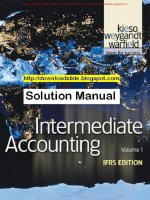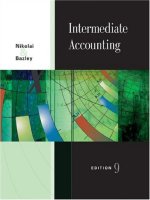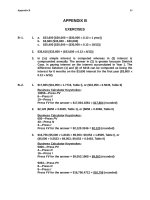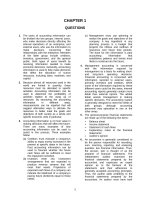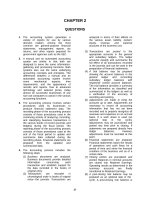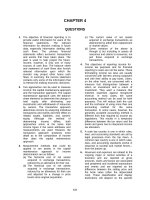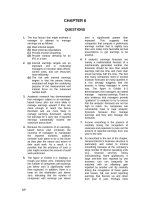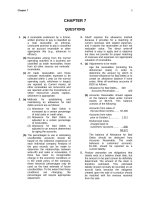Solution manual intermediate accounting 7th by nelson spiceland ch03
Bạn đang xem bản rút gọn của tài liệu. Xem và tải ngay bản đầy đủ của tài liệu tại đây (490.64 KB, 45 trang )
Find more slides, ebooks, solution manual and testbank on www.downloadslide.com
Chapter 3
The Balance Sheet and Financial Disclosures
QUESTIONS FOR REVIEW OF KEY TOPICS
Question 3-1
The purpose of the balance sheet, also known as the statement of financial position, is to
present the financial position of the company on a particular date. Unlike the income statement,
which is a change statement that reports events occurring during a period of time, the balance sheet
is a statement that presents an organized array of assets, liabilities, and shareholders’ equity at a
point in time. It is a freeze frame or snapshot picture of financial position at the end of a particular
day marking the end of an accounting period.
Question 3-2
The balance sheet does not portray the market value of the entity for a number of reasons.
Most assets are not reported at market value, but instead are measured according to historical cost.
Also, there are certain resources, such as trained employees, an experienced management team, and
a good reputation, that are not recorded as assets at all. Therefore, the assets of a company minus its
liabilities, as shown in the balance sheet, will not be representative of the company’s market value.
Question 3-3
Current assets include cash and other assets that are reasonably expected to be converted to
cash or consumed during one year, or within the normal operating cycle of the business if the
operating cycle is longer than one year. The typical asset categories classified as current assets
include:
— Cash and cash equivalents
— Short-term investments
— Accounts receivable
— Inventories
— Prepaid expenses
Question 3-4
Current liabilities are those obligations that are expected to be satisfied through the use of
current assets or the creation of other current liabilities. So, this classification will include all
liabilities that are scheduled to be liquidated within one year or the operating cycle, whichever is
longer, except those that management intends to refinance on a long-term basis. The typical liability
categories classified as current liabilities include:
— Accounts payable
— Short-term notes payable
— Accrued liabilities
— Current maturities of long-term debt
Solutions Manual, Vol.1, Chapter 3
© The McGraw-Hill Companies, Inc., 2007
3-1
Find more slides, ebooks, solution manual and testbank on www.downloadslide.com
Answers to Questions (continued)
Question 3-5
The operating cycle for a typical manufacturing company refers to the period of time required
to convert cash to raw materials, raw materials to a finished product, finished product to receivables,
and then finally receivables back to cash.
Question 3-6
Investments in equity securities are classified as current if the company’s management (1)
intends to liquidate the investment in the next year or operating cycle, whichever is longer, and (2)
has the ability to do so, i.e., the investment is marketable. If either of these criteria does not hold, the
investment is classified as noncurrent.
Question 3-7
The common characteristics that these assets have in common are that they are tangible, longlived assets used in the operations of the business. They usually are the primary revenue-generating
assets of the business. These assets include land, buildings, equipment, machinery, furniture and
other assets used in the operations of the business, as well as natural resources, such as mineral
mines, timber tracts and oil wells.
Question 3-8
Property, plant, and equipment and intangible assets each represent assets that are long-lived
and are used in the operations of the business. The difference is that property, plant, and equipment
represent physical assets, while intangibles lack physical substance. Generally, intangibles represent
the ownership of an exclusive right, such as a patent, copyright or franchise.
Question 3-9
A note payable of $100,000 due in five years would be classified as a long-term liability. A
$100,000 note due in five annual installments of $20,000 each would be classified as a $20,000
current liability — current maturities of long-term debt — and an $80,000 long-term liability.
Question 3-10
Paid-in-capital consists of amounts invested by shareholders in the corporation. Retained
earnings equals net income less dividends paid to shareholders from the inception of the corporation.
Question 3-11
Disclosure notes provide additional detail concerning specific financial statement items.
Included are such data as the market values of financial instruments and off-balance-sheet risk
associated with financial instruments and details of pension plans, leases, debt, and assets. Common
to all companies’ disclosures are certain specific notes such as a summary of significant accounting
policies, descriptions of subsequent events, and related third-party transactions. However, many
notes are designed to fit the disclosure needs of the particular reporting company. In fact, any
explanation that helps investors and creditors make decisions should be included.
© The McGraw-Hill Companies, Inc., 2007
3-2
Intermediate Accounting, 4/e
Find more slides, ebooks, solution manual and testbank on www.downloadslide.com
Answers to Questions (continued)
Question 3-12
The disclosure of the company’s significant accounting policies is extremely important to
external users in terms of their ability to compare financial information across companies. It is
critical to a financial analyst involved in assessing future cash flows of two construction companies
to know that one company uses the percentage-of-completion method in recognizing gross profit,
while the other company uses the completed contract method.
Question 3-13
A subsequent event is an event that occurs after the date of the financial statements but prior to
the date on which the statements are actually issued. It may help to clarify a previously existing
situation or it may represent a new event not directly affecting financial position at the end of the
reporting period.
Question 3-14
The discussion provides management’s views on significant events, trends and uncertainties
pertaining to the company’s (a) operations, (b) liquidity, and (c) capital resources. Certainly the
Management Discussion and Analysis section may be slanted to management’s biased perspective
and therefore can lack objectivity. However, management can offer an informed insight that might
not be available elsewhere, so if the reader maintains awareness of the information’s source, it can
offer a unique view of the situation.
Question 3-15
Depending on the circumstances, the auditor will issue a (an):
1. Unqualified opinion – The auditors are satisfied that the financial statements “present fairly” the
financial position, results of operations, and cash flows and are “prepared in accordance with
generally accepted accounting principles.”
2. Qualified opinion – This contains an exception to the standard unqualified opinion, but not of
sufficient seriousness to invalidate the financial statements as a whole. Examples of exceptions
are (a) unconformity with generally accepted accounting principles, (b) inadequate disclosures,
and (c) a limitation or restriction of the scope of the examination.
3. Adverse opinion – This is necessary when the exceptions are so serious that a qualified opinion
is not justified. Adverse opinions are rare because auditors usually are able to persuade
management to rectify problems to avoid this undesirable report.
4. Disclaimer – An auditor will disclaim an opinion if insufficient information has been gathered
to express an opinion.
Question 3-16
A proxy statement must be sent each year to all shareholders. It usually is in the same mailing
with the annual report. The statement invites shareholders to the shareholders’ meeting to elect
board members and to vote on issues before the shareholders. It also permits shareholders to vote
using an enclosed proxy card. Beginning with 1992 financial statements, the proxy statement also
provides for more disclosures on compensation to directors and executives, and in particular, stock
options granted to executives.
Solutions Manual, Vol.1, Chapter 3
© The McGraw-Hill Companies, Inc., 2007
3-3
Find more slides, ebooks, solution manual and testbank on www.downloadslide.com
Answers to Questions (concluded)
Question 3-17
Working capital is the difference between current assets and current liabilities. The current
ratio is computed by dividing current assets by current liabilities. The acid-test ratio (or quick ratio)
is computed by dividing quick assets (cash and cash equivalents, marketable securities, and accounts
receivable) by current liabilities.
Question 3-18
Debt to equity ratio
=
Times interest earned ratio
=
Total liabilities
Shareholders' equity
Net income + interest + taxes
Interest
Question 3-19
An operating segment is a component of an enterprise:
1. That engages in business activities from which it may earn revenues and incur expenses
(including revenues and expenses relating to transactions with other components of the same
enterprise).
2. Whose operating results are regularly reviewed by the enterprise's chief operating decisionmaker to make decisions about resources to be allocated to the segment, and to assess its
performance.
3. For which discrete financial information is available.
Question 3-20
For areas determined to be reportable operating segments, the following disclosures are required:
1. General information about the operating segment,
2. Information about reported segment profit or loss, including certain revenues and expenses
included in reported segment profit or loss, segments assets, and the basis of measurement.
3. Reconciliations of the totals of segment revenues, reported profit or loss, assets, and other
significant items to corresponding enterprise amounts.
4. Interim period information.
© The McGraw-Hill Companies, Inc., 2007
3-4
Intermediate Accounting, 4/e
Find more slides, ebooks, solution manual and testbank on www.downloadslide.com
BRIEF EXERCISES
Brief Exercise 3-1
(a)
(b)
(c)
(d)
(e)
(f)
Current
Current
Noncurrent
Current
Noncurrent
Noncurrent
Brief Exercise 3-2
Current Assets:
$16,000 + 11,000 + 25,000 = $52,000
Current liabilities:
$14,000 + 9,000 + 1,000 = $24,000
Brief Exercise 3-3
Assets:
minus
Liabilities
equals
Shareholders’ equity
Solutions Manual, Vol.1, Chapter 3
$ 52,000 current assets
80,000 equipment
$132,000 total assets
$ 24,000 current liabilities
30,000 notes payable
54,000 total liabilities
$78,000
(50,000) common stock
$28,000 retained earnings
© The McGraw-Hill Companies, Inc., 2007
3-5
Find more slides, ebooks, solution manual and testbank on www.downloadslide.com
Brief Exercise 3-4
K and J Nursery, Inc.
Balance Sheet
At December 31, 2006
Assets
Current assets:
Cash .................................................................
Accounts receivable .........................................
Inventories .......................................................
Total current assets ......................................
Property, plant, and equipment:
Equipment ........................................................
Less: Accumulated depreciation .......................
Net property, plant, and equipment .............
Total assets ...............................................
$ 16,000
11,000
25,000
52,000
$140,000
(60,000)
80,000
$132,000
Liabilities and Shareholders' Equity
Current liabilities:
Accounts payable .............................................
Wages payable .................................................
Interest payable ................................................
Total current liabilities ................................
$ 14,000
9,000
1,000
24,000
Long-term liabilities:
Note payable ....................................................
Shareholders’ equity:
Common stock .................................................
Retained earnings* ...........................................
Total shareholders’ equity ...........................
Total liabilities and shareholders’ equity
30,000
$50,000
28,000
78,000
$132,000
$28,000 is the amount needed to cause total assets to equal total liabilities and
shareholders’ equity. This is calculated in BE 3-3.
© The McGraw-Hill Companies, Inc., 2007
3-6
Intermediate Accounting, 4/e
Find more slides, ebooks, solution manual and testbank on www.downloadslide.com
Brief Exercise 3-5
Culver City Lighting, Inc.
Balance Sheet
At December 31, 2006
Assets
Current assets:
Cash .................................................................
Accounts receivable .........................................
Inventories .......................................................
Prepaid insurance .............................................
Total current assets ......................................
Property, plant, and equipment:
Equipment ........................................................
Less: Accumulated depreciation .......................
Net property, plant, and equipment .............
$ 55,000
39,000
45,000
15,000
154,000
$100,000
(34,000)
66,000
Intangibles:
Patent .............................................................
Total assets ...............................................
40,000
$260,000
Liabilities and Shareholders' Equity
Current liabilities:
Accounts payable .............................................
Interest payable .................................................
Current maturities of long-term debt ................
Total current liabilities ................................
$ 12,000
2,000
10,000
24,000
Long-term liabilities:
Note payable ....................................................
Shareholders’ equity:
Common stock .................................................
Retained earnings .............................................
Total shareholders’ equity ...........................
Total liabilities and shareholders’ equity
Solutions Manual, Vol.1, Chapter 3
90,000
$70,000
76,000
146,000
$260,000
© The McGraw-Hill Companies, Inc., 2007
3-7
Find more slides, ebooks, solution manual and testbank on www.downloadslide.com
Brief Exercise 3-6
1.
2.
3.
The $30,000 should be classified as a noncurrent asset, under the
investments and funds classification.
$10,000, next year’s installment, should be classified as a current liability,
current maturities of long-term debt. The remaining $90,000 is included in
long-term liabilities.
Two-thirds of the unearned revenue, $40,000, should be classified as a
current liability, the remaining $20,000 as a long-term liability.
Brief Exercise 3-7
Current assets – cash and cash equivalents – accounts receivable = Inventories
$235,000 –
40,000
–
120,000
= $75,000
Total assets – current assets = property, plant, and equipment
$400,000 – 235,000 =
$165,000
Total assets – accounts payable – note payable – common stock = retained
earnings
$400,000 –
32,000
–
50,000 –
100,000
= $218,000
Brief Exercise 3-8
(1)
(2)
(3)
(4)
(5)
(6)
A
B
B
A
B
A
Brief Exercise 3-9
(a)
Current assets
© The McGraw-Hill Companies, Inc., 2007
3-8
÷
current liabilities
Intermediate Accounting, 4/e
Find more slides, ebooks, solution manual and testbank on www.downloadslide.com
($55,000 + 39,000 + 45,000 + 15,000) ÷ ($12,000 + 2,000 + 10,000)
$154,000
÷
$24,000 = 6.42
(b) (Cash + short-term investments + accounts receivable) ÷ current liabilities
($55,000 + 0 + 39,000)
÷
$24,000 = 3.92
(c) Total liabilities ÷ shareholders’ equity
$24,000 current liabilities + 90,000 long-term liabilities = $114,000
$70,000 common stock + 76,000 retained earnings = $146,000
$114,000 ÷ $146,000 = .78
Brief Exercise 3-10
Paying accounts payable reduces both current assets and current liabilities. If
the ratio before the payment were above 1.0, the transaction would cause the ratio
to increase. However, if the ratio before the transaction were less than 1.0, the
ratio would decrease.
Brief Exercise 3-11
Acid-test ratio = (cash + short-term investments + A/R) ÷ current liabilities
1.5 = ($20,000 + 0 + 40,000) ÷ current liabilities
1.5 x current liabilities = $60,000
current liabilities = $60,000 ÷ 1.5
current liabilities = $40,000
Current ratio = current assets ÷ current liabilities
2.0 = current assets ÷ $40,000
current assets = $40,000 x 2.0
current assets = $80,000
$80,000 – 20,000(cash) – 40,000(A/R) = $20,000 inventories
Solutions Manual, Vol.1, Chapter 3
© The McGraw-Hill Companies, Inc., 2007
3-9
Find more slides, ebooks, solution manual and testbank on www.downloadslide.com
EXERCISES
Exercise 3-1
1. Total current assets
Current liabilities = $44,000 + 15,000 + 1,000 (accrued interest)
= $60,000
Since the current ratio is 1.5:1, current assets = 1.5 x $60,000 = $90,000
2. Short-term investments
$90,000 - 5,000 - 20,000 - 60,000 = $5,000
3. Retained earnings
Current assets + Noncurrent assets = Current liabilities + Long-term liabilities
+ Paid-in capital + Retained earnings (RE)
$90,000 + 120,000 = $60,000 + 30,000 (Note payable) + 100,000 + RE
RE = $20,000
Exercise 3-2
1.
2.
3.
4.
5.
6.
7.
8.
9.
c
f
-a
b_
g_
f
f
i
b
Equipment
Accounts payable
Allowance for uncollectible accounts
Land, held for investment
Note payable, due in 5 years
Unearned rent revenue
Note payable, due in 6 months
Income less dividends, accumulated
Investment in XYZ Corp., long-term
© The McGraw-Hill Companies, Inc., 2007
3-10
10.
11.
12.
13.
14.
15.
16.
17.
18.
a
d
c
f
a
h
c
a
f
Inventories
Patent
Land, in use
Accrued liabilities
Prepaid rent
Common stock
Building, in use
Cash
Taxes payable
Intermediate Accounting, 4/e
Find more slides, ebooks, solution manual and testbank on www.downloadslide.com
Exercise 3-3
1.
2.
3.
4.
5.
6.
7.
8.
9.
f
Accrued interest payable
d
Franchise
-c
Accumulated depreciation
e Prepaid insurance, for 2005
g
Bonds payable, due in 10 years
f
Current maturities of long-term debt
f
Note payable, due in 3 months
b
Long-term receivables
b
Bond sinking fund, will be used to
retire bonds in 10 years
Solutions Manual, Vol.1, Chapter 3
10.
11.
12.
13.
14.
15.
16.
17.
18.
a
c
c
f
d
h
b
a
f
Supplies
Machinery
Land, in use
Unearned revenue
Copyrights
Preferred stock
Land, held for speculation
Cash equivalents
Wages payable
© The McGraw-Hill Companies, Inc., 2007
3-11
Find more slides, ebooks, solution manual and testbank on www.downloadslide.com
Exercise 3-4
JACKSON CORPORATION
Balance Sheet
At December 31, 2006
Assets
Current assets:
Cash .................................................................
Marketable securities ........................................
Accounts receivable .........................................
Inventories .......................................................
Prepaid rent ......................................................
Total current assets ......................................
Property, plant, and equipment:
Machinery ........................................................
Less: Accumulated depreciation .......................
Net property, plant, and equipment .............
$ 40,000
10,000
34,000
75,000
16,000
175,000
$145,000
(11,000)
134,000
Intangibles:
Patent .............................................................
Total assets ...............................................
83,000
$392,000
Liabilities and Shareholders' Equity
Current liabilities:
Accounts payable .............................................
Wages payable .................................................
Taxes payable ...................................................
Total current liabilities ................................
$ 8,000
4,000
32,000
44,000
Long-term liabilities:
Bonds payable ..................................................
200,000
Shareholders’ equity:
Common stock .................................................
Retained earnings .............................................
Total shareholders’ equity ...........................
Total liabilities and shareholders’ equity
© The McGraw-Hill Companies, Inc., 2007
3-12
$100,000
48,000
148,000
$392,000
Intermediate Accounting, 4/e
Find more slides, ebooks, solution manual and testbank on www.downloadslide.com
Exercise 3-5
VALLEY PUMP CORPORATION
Balance Sheet
At December 31, 2006
Assets
Current assets:
Cash .............................................................................
Marketable securities ....................................................
Accounts receivable, net of allowance for
uncollectible accounts of $5,000 .............................
Inventories ....................................................................
Prepaid expenses ..........................................................
Total current assets .................................................
$ 25,000
22,000
51,000
81,000
32,000
211,000
Investments:
Marketable securities ....................................................
Land .............................................................................
Total investments ....................................................
Property, plant, and equipment:
Land .............................................................................
Buildings ......................................................................
Equipment ....................................................................
Less: Accumulated depreciation ...................................
Net property, plant, and equipment .........................
$22,000
20,000
42,000
100,000
300,000
75,000
475,000
(125,000)
350,000
Intangibles:
Copyright .....................................................................
Total assets ..........................................................
12,000
$615,000
Liabilities and Shareholders' Equity
Current liabilities:
Accounts payable ..........................................................
Interest payable .............................................................
Unearned revenues .......................................................
Note payable .................................................................
Current maturities of long-term debt .............................
Total current liabilities ............................................
$ 65,000
10,000
20,000
100,000
50,000
245,000
Long-term liabilities:
Note payable .................................................................
100,000
Shareholders’ equity:
Common stock ..............................................................
Retained earnings .........................................................
Total shareholders’ equity .......................................
Total liabilities and shareholders’ equity ..............
Solutions Manual, Vol.1, Chapter 3
$200,000
70,000
270,000
$615,000
© The McGraw-Hill Companies, Inc., 2007
3-13
Find more slides, ebooks, solution manual and testbank on www.downloadslide.com
Exercise 3-6
LOS GATOS CORPORATION
Balance Sheet
At December 31, 2006
Assets
Current assets:
Cash .......................................................................
Accounts receivable, net of allowance for
uncollectible accounts of $5,000 .........................
Inventories .............................................................
Total current assets ...........................................
$ 20,000
55,000
55,000
130,000
Investments:
Bond sinking fund ..................................................
Note receivable ......................................................
Total investments ..............................................
$ 20,000
20,000
Property, plant, and equipment:
Machinery ..............................................................
Less: Accumulated depreciation .............................
Net property, plant, and equipment ...................
190,000
(70,000)
40,000
120,000
Intangibles:
Franchise ................................................................
Total assets .....................................................
30,000
$320,000
Liabilities and Shareholders' Equity
Current liabilities:
Accounts payable ...................................................
Interest payable ......................................................
Note payable ..........................................................
Total current liabilities ......................................
$ 50,000
5,000
50,000
105,000
Long-term liabilities:
Bonds payable ........................................................
110,000
Shareholders’ equity:
Common stock, no par value; 100,000 shares
authorized; 50,000 shares issued and outstanding
Retained earnings ...................................................
Total shareholders’ equity .................................
Total liabilities and shareholders’ equity ........
© The McGraw-Hill Companies, Inc., 2007
3-14
$ 70,000
35,000
105,000
$320,000
Intermediate Accounting, 4/e
Find more slides, ebooks, solution manual and testbank on www.downloadslide.com
Exercise 3-7
CONE CORPORATION
Balance Sheet (Partial)
At December 31, 2006
Assets
Current assets:
Marketable securities ........................................
Prepaid rent ......................................................
$ 40,000
12,000
Investments:
Bond sinking fund ............................................
Marketable securities ........................................
50,000
40,000
Other assets:
Prepaid rent (1) ..................................................
12,000
Liabilities and Shareholders' Equity
Current liabilities:
Interest payable .................................................
Current maturities of long-term debt .................
Long-term liabilities:
Note payable .....................................................
$ 12,000
20,000
180,000
(1) Note: In practice, companies often report all prepaid expenses as
current assets.
Solutions Manual, Vol.1, Chapter 3
© The McGraw-Hill Companies, Inc., 2007
3-15
Find more slides, ebooks, solution manual and testbank on www.downloadslide.com
Exercise 3-8
See calculations below the balance sheet.
Korver Supply Company
Balance Sheet
At December 31, 2006
Assets
Current assets:
Cash .................................................................
Accounts receivable .........................................
Inventories .......................................................
Total current assets ......................................
Property, plant, and equipment:
Furniture and fixtures .......................................
Less: Accumulated depreciation .......................
Net property, plant, and equipment .............
Total assets ...............................................
$168,000
320,000
250,000
738,000
$300,000
(170,000)
130,000
$868,000
Liabilities and Shareholders' Equity
Current liabilities:
Accounts payable .............................................
Interest payable ................................................
Note payable ....................................................
Total current liabilities ................................
$180,000
6,000
200,000
386,000
Shareholders’ equity:
Common stock .................................................
Retained earnings .............................................
Total shareholders’ equity ...........................
Total liabilities and shareholders’ equity
482,000
$868,000
$100,000
382,000
Exercise 3-8 (concluded)
© The McGraw-Hill Companies, Inc., 2007
3-16
Intermediate Accounting, 4/e
Find more slides, ebooks, solution manual and testbank on www.downloadslide.com
Beginning balance in cash
+ Cash collected from customers
- Cash paid to suppliers
- Cash paid for operating expenses
- Cash paid for interest
Ending cash balance
$120,000
780,000
(560,000)
(160,000)
(12,000)
$168,000
Beginning balance in accounts receivable
+ Credit sales
- Cash collected from customers
Ending balance in accounts receivable
$300,000
800,000
(780,000)
$320,000
Beginning balance in inventories
+ Purchases
- Cost of merchandise sold
Ending balance in inventories
$200,000
550,000
(500,000)
$250,000
Beginning balance in furniture and fixtures, net
- Depreciation for the year
Ending balance in furniture and fixtures, net
$150,000
(20,000)
$130,000
Beginning balance in accounts payable
+ Purchases on account
- Cash paid to suppliers
Ending balance in accounts payable
$190,000
550,000
(560,000)
$180,000
Beginning balance in retained earnings
+ Sales revenue
- Cost of goods sold
- Operating expenses
- Depreciation expense
- Interest expense
Ending balance in retained earnings
$274,000
800,000
(500,000)
(160,000)
(20,000)
(12,000)
$382,000
Accrued interest on note ($200,000 x 6% x 6/12)
Solutions Manual, Vol.1, Chapter 3
$6,000
© The McGraw-Hill Companies, Inc., 2007
3-17
Find more slides, ebooks, solution manual and testbank on www.downloadslide.com
Exercise 3-9
1.
2.
3.
4.
5.
6.
7.
8.
Inventory costing method
Information on related party transactions
Composition of property, plant, and equipment
Depreciation method
Subsequent event information
Basis of revenue recognition on long-term contracts
Important merger occurring after year-end
Composition of receivables
A
B
B
A
B
A
B
B
Exercise 3-10
1.
2.
3.
4.
5.
When related-party transactions occur, companies must disclose the nature of the
relationship, provide a description of the transaction, and report the dollar
amounts of the transactions and any amounts due from or to related parties.
When an event that has a material effect on the company’s financial position
occurs after the fiscal year-end, but before the financial statements actually are
issued, the event is disclosed in a subsequent event disclosure note.
The choice of the straight-line method to determine depreciation typically is
disclosed in the company’s summary of significant accounting policies disclosure
note.
This information would be included in a disclosure note describing the
company’s debt.
The choice of the FIFO method to determine value inventory typically is
disclosed in the company’s summary of significant accounting policies disclosure
note.
Exercise 3-11
1.
2.
3.
a
c
c
© The McGraw-Hill Companies, Inc., 2007
3-18
Intermediate Accounting, 4/e
Find more slides, ebooks, solution manual and testbank on www.downloadslide.com
Exercise 3-12
List A
d
h
1. Balance sheet
2. Liquidity
b
3. Current assets
j
a
4. Operating cycle
5. Current liabilities
k
m
6. Cash equivalent
7. Intangible asset
l
8. Working capital
g
9. Accrued liabilities
e
i
c
f
10. Summary of significant
accounting policies
11. Subsequent events
12. Unqualified opinion
13. Qualified opinion
List B
a. Will be satisfied through the use of current assets.
b. Items expected to be converted to cash or consumed
within one year or the operating cycle.
c. The statements are presented fairly in conformity
with GAAP.
d. An organized array of assets, liabilities and equity.
e. Important to a user in comparing financial
information across companies.
f. Scope limitation or a departure from GAAP.
g. Recorded when an expense is incurred but not yet
paid.
h. Relates to the amount of time before an asset is
converted to cash or a liability is paid.
i. Occurs after the fiscal year-end but before the
statements are issued.
j. Cash to cash.
k. One-month U.S. treasury bill.
l. Current assets minus current liabilities.
m. Lacks physical existence.
Exercise 3-13
1. Current ratio
2. Acid-test ratio
3. Debt to equity ratio
4. Times interest earned ratio
Solutions Manual, Vol.1, Chapter 3
[$200 + 150 + 200 + 350] ÷ $400 = 2.25
[$200 + 150 + 200] ÷ $400 = 1.375
[$400 + 350] ÷ [$750 + 400] = .65
[$160 + 40 + 100] ÷ $40 = 7.5 times
© The McGraw-Hill Companies, Inc., 2007
3-19
Find more slides, ebooks, solution manual and testbank on www.downloadslide.com
Exercise 3-14
1. Acid-test ratio = Quick assets ÷ Current liabilities =
Quick assets = Current assets - Inventories
Quick assets = Current assets - $840,000
1.20
Current assets ÷ Current liabilities =
Current assets - $840,000 ÷ Current liabilities =
$840,000 ÷ Current liabilities =
Current liabilities = $800,000
Current assets ÷ $800,000 = 2.25
Current assets = $1,800,000
2.25
1.20
1.05
2. Debt to equity ratio = Total liabilities ÷ Shareholders’ equity = 1.8
Total liabilities + Shareholders' equity = Total assets
Total liabilities + Shareholders' equity = $2,800,000
Let x equal shareholders' equity
1.8 x + x = $2,800,000
x = $1,000,000 = Shareholders' equity
3. Noncurrent assets = Total assets - Current assets
Noncurrent assets = $2,800,000 – 1,800,000 = $1,000,000
4. Long-term liabilities = Total assets - Current liabilities - Shareholders' equity
Long-term liabilities = $2,800,000 - 800,000 - 1,000,000 = $1,000,000
© The McGraw-Hill Companies, Inc., 2007
3-20
Intermediate Accounting, 4/e
Find more slides, ebooks, solution manual and testbank on www.downloadslide.com
Exercise 3-15
1.
2.
3.
4.
5.
6.
7.
8.
9.
10.
11.
Action
Issuance of long-term bonds
Issuance of short-term notes
Payment of accounts payable
Purchase of inventory on account
Purchase of inventory for cash
Purchase of equipment with a 4-year note
Retirement of bonds
Sale of common stock
Write-off of obsolete inventory
Purchase of short-term investment for cash
Decision to refinance on a long-term basis
some currently maturing debt
Current
Ratio
I
I
D
I
N
N
D
I
D
N
I
Acid-test
Debt to
Ratio Equity Ratio
I
I
I
I
D
D
D
I
D
N
N
I
D
D
I
D
N
I
N
N
I
N
Exercise 3-16
1.
2.
a
a
Solutions Manual, Vol.1, Chapter 3
© The McGraw-Hill Companies, Inc., 2007
3-21
Find more slides, ebooks, solution manual and testbank on www.downloadslide.com
Exercise 3-17
1. d. SFAS 57 requires disclosure of related-party transactions except for
compensation agreements, expense allowances, and transactions eliminated in
consolidated working papers. Required disclosures include the relationship(s)
of the related parties; a description and dollar amounts of transactions for each
period presented and the effects of any change in the method of establishing
their terms; and amounts due to or from the related parties and, if not apparent,
the terms and manner of settlement. The effect on the cash flow statement need
not be disclosed.
2. b. The MD&A section is included in SEC filings. It addresses in a nonquantified
manner the prospects of a company. The SEC examines it with care to
determine that management has disclosed material information affecting the
company’s future results. Disclosures about commitments and events that may
affect operations or liquidity are mandatory. Thus, the MD&A section pertains
to liquidity, capital resources, and results of operations.
3. c. The current ratio equals current assets divided by current liabilities. An equal
increase in both the numerator and denominator of a current ratio less than 1.0
causes the ratio to increase. Windham Company’s current ratio is .8 ($400,000/
$500,000). The purchase of $100,000 of inventory on account would increase
the current assets to $500,000 and the current liabilities to $600,000, resulting
in a new current ratio of .833.
© The McGraw-Hill Companies, Inc., 2007
3-22
Intermediate Accounting, 4/e
Find more slides, ebooks, solution manual and testbank on www.downloadslide.com
Exercise 3-18
Requirement 1
The pharmaceuticals, plastics and farm equipment segments are reportable. Only
segments representing 10% or more of total company revenues, assets or net income
must be reported. The electronics segment does not meet this criterion.
Requirement 2
For segments determined to be reportable, the following disclosures are required:
a. General information about the operating segment.
b. Information about reported segment profit or loss, including certain revenues and
expenses included in reported segment profit or loss, segments assets, and the basis
of measurement.
c. Reconciliations of the totals of segment revenues, reported profit or loss, assets,
and other significant items to corresponding enterprise amounts.
d. Interim period information.
Solutions Manual, Vol.1, Chapter 3
© The McGraw-Hill Companies, Inc., 2007
3-23
Find more slides, ebooks, solution manual and testbank on www.downloadslide.com
PROBLEMS
Problem 3-1
Balance Sheet
Assets
Current assets:
Cash
Short-term investments
Accounts receivable, net of allowance for uncollectible accounts
Interest receivable
Inventories
Prepaid expenses
Total current assets
Investments:
Bond sinking fund
Long-term investments
Notes receivable
Total investments
Property, plant, and equipment:
Land
Buildings
Equipment
Less: Accumulated depreciation
Net property, plant, and equipment
Intangibles:
Patent
Copyright
Total intangibles
Total assets
Liabilities and Shareholders' Equity
Current liabilities:
Accounts payable
Rent payable
Taxes payable
Wages payable
Notes payable
Total current liabilities
Long-term liabilities:
Bonds payable
Shareholders’ equity:
Common stock
Preferred stock
Retained earnings
Total shareholders’ equity
Total liabilities and shareholders’ equity
© The McGraw-Hill Companies, Inc., 2007
3-24
Intermediate Accounting, 4/e
Find more slides, ebooks, solution manual and testbank on www.downloadslide.com
Problem 3-2
Requirement 1
Inventories:
Current assets - Cash and cash equivalents - Short-term investments Accounts receivable - Prepaid expenses = Inventories
$1,594,927 - 239,186 - 353,700 - 504,944 - 83,259 = $413,838
Total assets:
Total liabilities + Shareholders’ equity = Total assets
$956,140 + 1,370,627 = $2,326,767
Property and equipment (net):
Total assets - Current assets - Long-term receivables = Property and equipment
$2,326,767 - 1,594,927 - 110,800 = $621,040
Accounts payable:
Total current liabilities - Notes payable and short-term debt - Accrued liabilities Other current liabilities = Accounts payable
$693,564 - 31,116 - 421,772 - 181,604 = $59,072
Long-term debt and deferred taxes:
Total liabilities - Current liabilities = Long-term debt and deferred taxes
$956,140 - 693,564 = $262,576
Solutions Manual, Vol.1, Chapter 3
© The McGraw-Hill Companies, Inc., 2007
3-25
